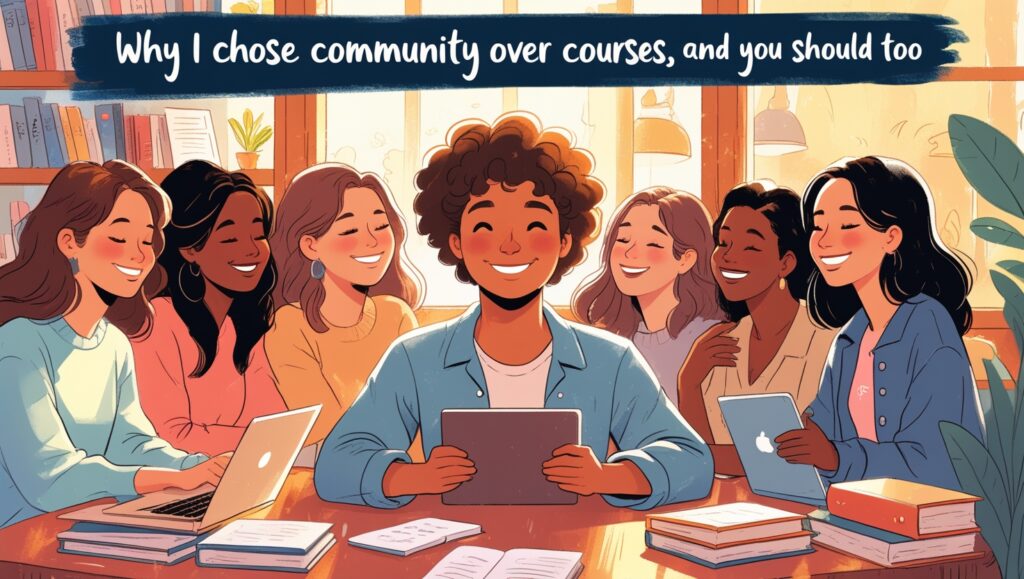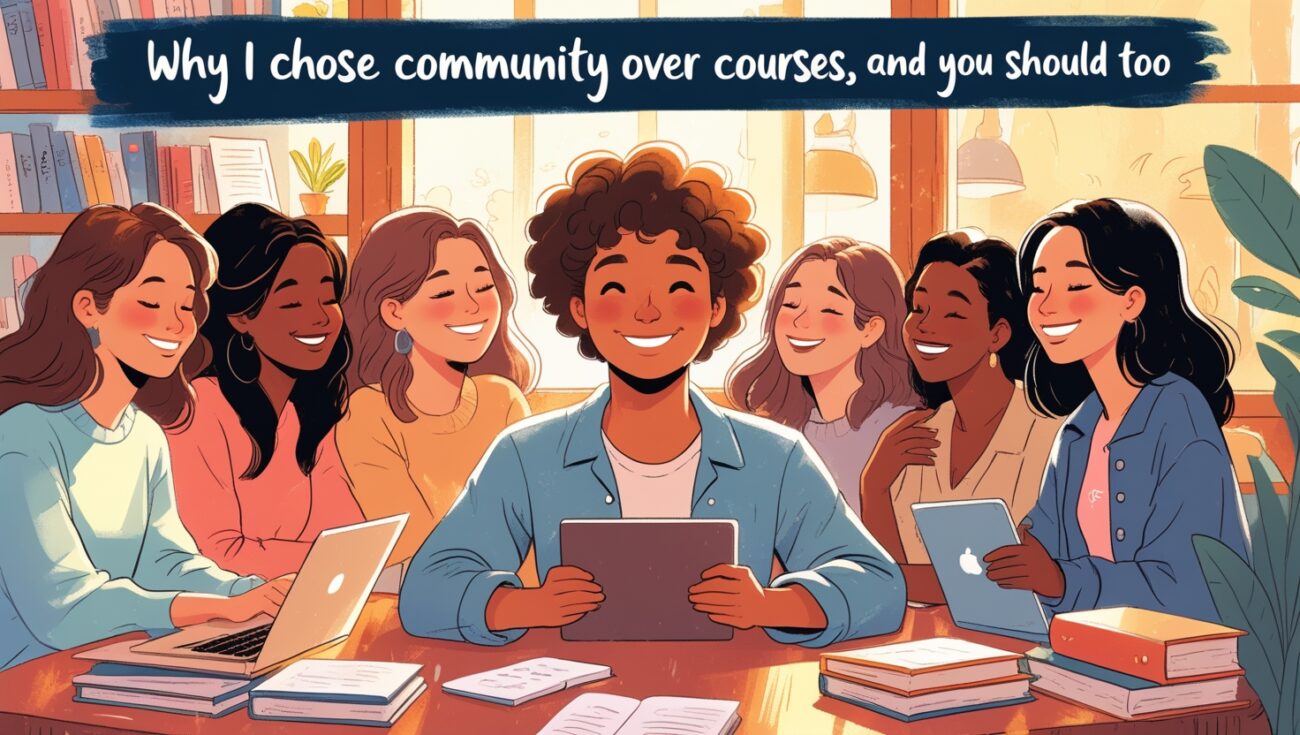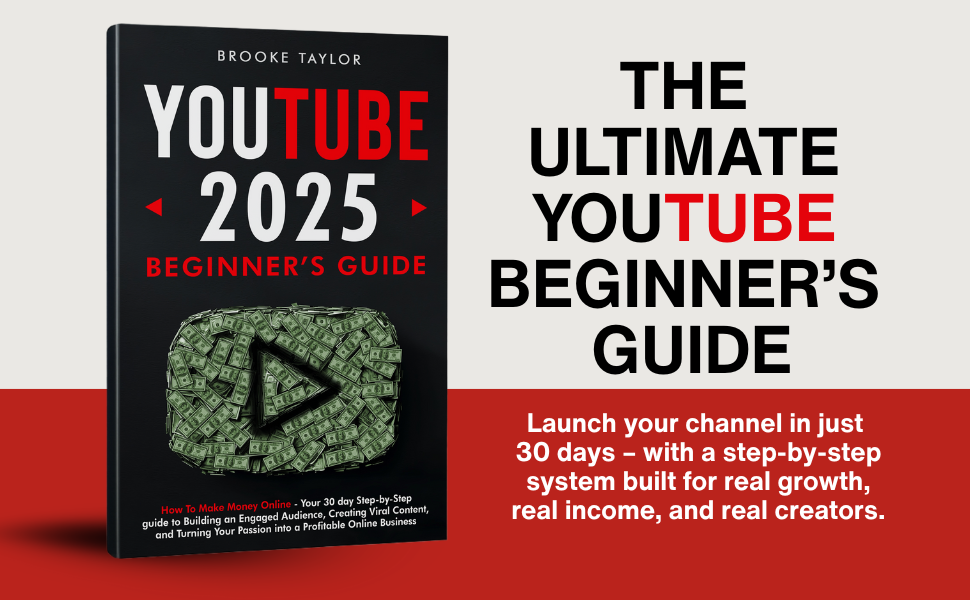Why I Chose Community Over Courses (And You Should Too)
When I first started creating digital products, I went straight to building online courses. Everyone was saying courses were the best way to scale, so I followed the crowd.
But here’s what I learned: courses are great for delivering information, but they rarely deliver transformation. That’s why I ultimately chose to build a community instead of just selling courses — and it completely changed my business.
In this post, I’ll explain why community is more powerful than courses alone and how you can build a thriving community of your own.

Table of Contents
1. Community Creates Real Connection
With courses, students are often on their own. They buy the content, watch a few lessons, and then life gets in the way.
When I switched to building a community, I saw a huge difference. Members were connecting with each other, supporting each other, and staying engaged. That connection kept them motivated to take action and get results.
2. Engagement Leads to Better Results
When people feel part of a group, they show up more. They ask questions, share wins, and stay accountable.
Courses can feel passive, but communities are interactive. And the truth is, people pay for results, not information. Community gives them the support they need to actually follow through.
3. Communities Build Recurring Revenue
Most courses are one-time purchases. Once someone buys, you’re back to finding the next customer.
With a community, you can charge a monthly or yearly membership fee. This creates predictable, recurring income and frees you from constantly launching new products.
Even 50 members paying $49/month is nearly $2,500 in steady revenue — without having to sell anything new each month.
4. Community Is Easier to Run Than You Think
I used to think building a community would be complicated, but it’s actually simpler than creating a big course.
Now I use Skool to run my community, and it gives me everything I need:
- A community feed for conversations
- A classroom for premium lessons and resources
- A calendar for live calls and events
- Built-in Stripe payments so I can charge monthly
If you’re ready to build your own community, sign up for Skool here: click this link to create your group now.
5. You Can Still Include Courses in Your Community
Here’s the best part: you don’t have to choose one or the other. I moved my existing courses into my community as part of the membership.
This made the community even more valuable, and it gave members a reason to stay subscribed long-term.
Final Thoughts
Courses aren’t bad, but community is where the real magic happens. It gives people the connection, accountability, and support they need to succeed — and it gives you predictable recurring income instead of constant launches.
Here’s what I recommend you do today:
- Stop trying to sell one-off courses
- Sign up for Skool here and create your community
- Invite your first 5–10 members and start building something people will love
Once you experience how powerful community can be, you’ll never want to go back to just selling courses again.
When I first started selling courses, I thought I had made it. I spent months creating high-quality videos, worksheets, and resources. But after the initial launch excitement, sales slowed down, and students weren’t finishing the material. That’s when I realized something was missing: connection.
Courses can deliver information, but most people need support and accountability to follow through. When I started building a community instead, I saw a huge change in how engaged people were. Members asked questions, encouraged each other, and celebrated wins together.
If you’re ready to build a connected, profitable community, sign up for Skool here: click this link to create your group now. You can have it up and running in less than an hour.
Another major difference is how predictable the income is. With courses, you’re always chasing the next launch. With a community, members pay you every month, which means you can focus on delivering value instead of constantly selling.
When I hit just 50 members paying $49/month, that was nearly $2,500 in recurring revenue. That stability gave me the freedom to create better content and serve my members without feeling stressed about where the next sale was coming from.
One of the things I love most about running a community is the relationships I build with my members. I get to know their names, their goals, and their challenges. That kind of connection isn’t possible when you’re just selling courses.
And here’s the best part: you can still offer your courses inside your community. I moved my existing courses into the classroom section of my Skool group, and it instantly made the membership more valuable. Members could watch the lessons and then discuss them in the community feed, which improved completion rates dramatically.
Here’s what you can do this week to start:
- Take any courses or content you already have
- Sign up for Skool here and create your community
- Upload your lessons in the classroom and start inviting members
You don’t need a massive audience to get started. My first community only had 8 paying members, but it was enough to validate the idea. Those early members gave me testimonials and referrals that helped me grow quickly.
Another benefit is how much easier it is to run a community. Instead of juggling Facebook Groups, course platforms, and payment systems, everything is in one place on Skool. I can post updates, host calls, and manage payments without any tech headaches.
Finally, remember that people stay for community, not just content. When members feel supported and connected, they’ll stay subscribed for months or even years. That’s how you build a business that lasts.
Click here to sign up for Skool now: launch your community and create recurring revenue today. You’ll be amazed at how much more impactful and sustainable your business will feel when you focus on community first.






